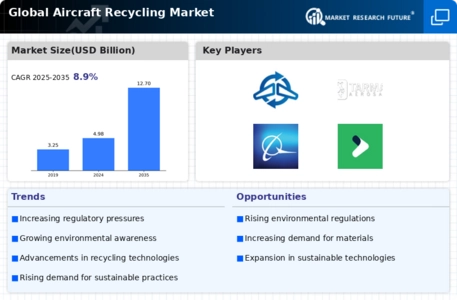Aircraft Recycling Size
Aircraft Recycling Market Growth Projections and Opportunities
The aircraft recycling market is influenced by various factors that shape its dynamics and growth prospects. Firstly, the global fleet of commercial aircraft is continuously expanding, leading to an increase in the number of retired and end-of-life aircraft. Factors such as technological advancements, changes in fuel efficiency standards, and airline fleet modernization initiatives contribute to the retirement of older aircraft models, creating a steady supply of aircraft for recycling.
Secondly, environmental regulations and sustainability goals drive the demand for aircraft recycling services. Governments and international aviation organizations impose stringent regulations on aircraft disposal and recycling to minimize environmental impact and promote sustainable practices. Aircraft recycling offers an environmentally responsible solution for managing end-of-life aircraft and reducing carbon emissions associated with traditional disposal methods such as landfilling or incineration.
Furthermore, technological advancements in aircraft design and materials influence the aircraft recycling market. Modern aircraft are constructed using advanced composite materials, lightweight alloys, and sophisticated electronic components, presenting unique challenges and opportunities for recycling. Innovations in recycling technologies, such as composite material recovery processes and automated dismantling techniques, enable efficient and environmentally friendly recycling of complex aircraft structures and components.
Moreover, economic factors such as metal prices, recycling costs, and market demand for recycled materials impact the profitability of aircraft recycling operations. The value of scrap metals recovered from retired aircraft, such as aluminum, titanium, and high-strength steel, fluctuates based on market demand and global economic conditions. Aircraft recyclers must assess market dynamics and optimize their operations to maximize the value extracted from recycled materials.
Additionally, regulatory frameworks and industry standards govern aircraft recycling practices and procedures. Aviation authorities and environmental agencies establish guidelines for aircraft decommissioning, dismantling, and recycling to ensure compliance with safety, environmental, and occupational health regulations. Certification programs such as the Aircraft Fleet Recycling Association (AFRA) accreditation provide industry standards and best practices for aircraft recycling companies, enhancing transparency and credibility in the market.
Furthermore, market competition and industry consolidation influence the aircraft recycling market. As the demand for aircraft recycling services grows, companies vie for market share through differentiation strategies, technological innovation, and service quality excellence. Mergers, acquisitions, and strategic partnerships among aircraft recyclers contribute to market consolidation and the emergence of larger, more diversified players in the industry.
Moreover, public awareness and corporate responsibility initiatives play a role in driving demand for sustainable aircraft recycling solutions. Airlines, aircraft manufacturers, and leasing companies increasingly prioritize environmental stewardship and social responsibility in their business practices. Partnering with reputable aircraft recyclers and adopting sustainable end-of-life aircraft management practices aligns with corporate sustainability goals and enhances brand reputation.
Lastly, technological innovation and research and development efforts drive advancements in aircraft recycling processes and techniques. Collaborative research initiatives between academia, industry, and government agencies foster innovation in recycling technologies, materials recovery methods, and waste reduction strategies. Investments in research and development contribute to the continuous improvement of aircraft recycling practices and the evolution of the aircraft recycling market.








Leave a Comment